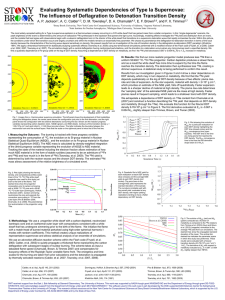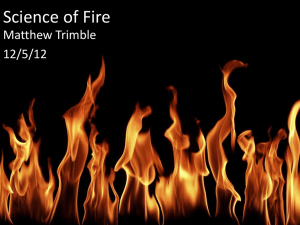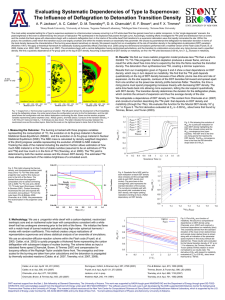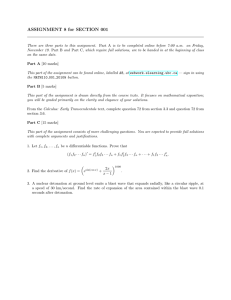A. P. Jackson, A. C. Calder (Stony Brook University), and...
advertisement
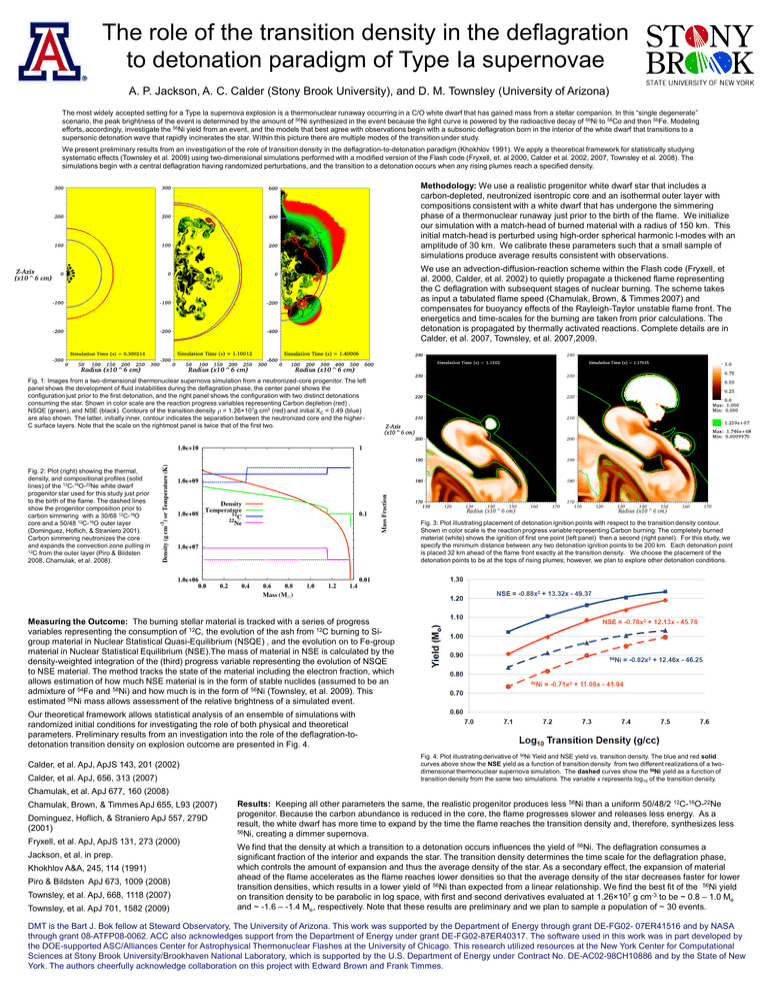
The role of the transition density in the deflagration to detonation paradigm of Type Ia supernovae A. P. Jackson, A. C. Calder (Stony Brook University), and D. M. Townsley (University of Arizona) The most widely accepted setting for a Type Ia supernova explosion is a thermonuclear runaway occurring in a C/O white dwarf that has gained mass from a stellar companion. In this “single degenerate” scenario, the peak brightness of the event is determined by the amount of 56Ni synthesized in the event because the light curve is powered by the radioactive decay of 56Ni to 56Co and then 56Fe. Modeling efforts, accordingly, investigate the 56Ni yield from an event, and the models that best agree with observations begin with a subsonic deflagration born in the interior of the white dwarf that transitions to a supersonic detonation wave that rapidly incinerates the star. Within this picture there are multiple modes of the transition under study. We present preliminary results from an investigation of the role of transition density in the deflagration-to-detonation paradigm (Khokhlov 1991). We apply a theoretical framework for statistically studying systematic effects (Townsley et al. 2009) using two-dimensional simulations performed with a modified version of the Flash code (Fryxell, et. al 2000, Calder et al. 2002, 2007, Townsley et al. 2008). The simulations begin with a central deflagration having randomized perturbations, and the transition to a detonation occurs when any rising plumes reach a specified density. Methodology: We use a realistic progenitor white dwarf star that includes a carbon-depleted, neutronized isentropic core and an isothermal outer layer with compositions consistent with a white dwarf that has undergone the simmering phase of a thermonuclear runaway just prior to the birth of the flame. We initialize our simulation with a match-head of burned material with a radius of 150 km. This initial match-head is perturbed using high-order spherical harmonic l-modes with an amplitude of 30 km. We calibrate these parameters such that a small sample of simulations produce average results consistent with observations. We use an advection-diffusion-reaction scheme within the Flash code (Fryxell, et al. 2000, Calder, et al. 2002) to quietly propagate a thickened flame representing the C deflagration with subsequent stages of nuclear burning. The scheme takes as input a tabulated flame speed (Chamulak, Brown, & Timmes 2007) and compensates for buoyancy effects of the Rayleigh-Taylor unstable flame front. The energetics and time-scales for the burning are taken from prior calculations. The detonation is propagated by thermally activated reactions. Complete details are in Calder, et al. 2007, Townsley, et al. 2007,2009. Fig. 1: Images from a two-dimensional thermonuclear supernova simulation from a neutronized-core progenitor. The left panel shows the development of fluid instabilities during the deflagration phase, the center panel shows the configuration just prior to the first detonation, and the right panel shows the configuration with two distinct detonations consuming the star. Shown in color scale are the reaction progress variables representing Carbon depletion (red) , NSQE (green), and NSE (black). Contours of the transition density = 1.26×107g cm3 (red) and initial XC = 0.49 (blue) are also shown. The latter, initially inner, contour indicates the separation between the neutronized core and the higherC surface layers. Note that the scale on the rightmost panel is twice that of the first two. Fig. 2: Plot (right) showing the thermal, density, and compositional profiles (solid lines) of the 12C-16O-22Ne white dwarf progenitor star used for this study just prior to the birth of the flame. The dashed lines show the progenitor composition prior to carbon simmering with a 30/68 12C-16O core and a 50/48 12C-16O outer layer (Dominguez, Hoflich, & Straniero 2001). Carbon simmering neutronizes the core and expands the convection zone pulling in 12C from the outer layer (Piro & Bildsten 2008, Chamulak, et al. 2008). Fig. 3: Plot illustrating placement of detonation ignition points with respect to the transition density contour. Shown in color scale is the reaction progress variable representing Carbon burning. The completely burned material (white) shows the ignition of first one point (left panel) then a second (right panel). For this study, we specify the minimum distance between any two detonation ignition points to be 200 km. Each detonation point is placed 32 km ahead of the flame front exactly at the transition density. We choose the placement of the detonation points to be at the tops of rising plumes; however, we plan to explore other detonation conditions. Measuring the Outcome: The burning stellar material is tracked with a series of progress variables representing the consumption of 12C, the evolution of the ash from 12C burning to Sigroup material in Nuclear Statistical Quasi-Equilibrium (NSQE) , and the evolution on to Fe-group material in Nuclear Statistical Equilibrium (NSE).The mass of material in NSE is calculated by the density-weighted integration of the (third) progress variable representing the evolution of NSQE to NSE material. The method tracks the state of the material including the electron fraction, which allows estimation of how much NSE material is in the form of stable nuclides (assumed to be an admixture of 54Fe and 58Ni) and how much is in the form of 56Ni (Townsley, et al. 2009). This estimated 56Ni mass allows assessment of the relative brightness of a simulated event. Our theoretical framework allows statistical analysis of an ensemble of simulations with randomized initial conditions for investigating the role of both physical and theoretical parameters. Preliminary results from an investigation into the role of the deflagration-todetonation transition density on explosion outcome are presented in Fig. 4. Calder, et al. ApJ, ApJS 143, 201 (2002) Calder, et al. ApJ, 656, 313 (2007) Fig. 4: Plot illustrating derivative of 56Ni Yield and NSE yield vs. transition density. The blue and red solid curves above show the NSE yield as a function of transition density from two different realizations of a twodimensional thermonuclear supernova simulation. The dashed curves show the 56Ni yield as a function of transition density from the same two simulations. The variable x represents log10 of the transition density. Chamulak, et al. ApJ 677, 160 (2008) Chamulak, Brown, & Timmes ApJ 655, L93 (2007) Dominguez, Hoflich, & Straniero ApJ 557, 279D (2001) Fryxell, et al. ApJ, ApJS 131, 273 (2000) Jackson, et al. in prep. Khokhlov A&A, 245, 114 (1991) Piro & Bildsten ApJ 673, 1009 (2008) Townsley, et al. ApJ, 668, 1118 (2007) Townsley, et al. ApJ 701, 1582 (2009) Results: Keeping all other parameters the same, the realistic progenitor produces less 56Ni than a uniform 50/48/2 12C-16O-22Ne progenitor. Because the carbon abundance is reduced in the core, the flame progresses slower and releases less energy. As a result, the white dwarf has more time to expand by the time the flame reaches the transition density and, therefore, synthesizes less 56Ni, creating a dimmer supernova. We find that the density at which a transition to a detonation occurs influences the yield of 56Ni. The deflagration consumes a significant fraction of the interior and expands the star. The transition density determines the time scale for the deflagration phase, which controls the amount of expansion and thus the average density of the star. As a secondary effect, the expansion of material ahead of the flame accelerates as the flame reaches lower densities so that the average density of the star decreases faster for lower transition densities, which results in a lower yield of 56Ni than expected from a linear relationship. We find the best fit of the 56Ni yield on transition density to be parabolic in log space, with first and second derivatives evaluated at 1.26×107 g cm-3 to be ~ 0.8 – 1.0 Mסּ and ~ -1.6 – -1.4 Mסּ, respectively. Note that these results are preliminary and we plan to sample a population of ~ 30 events. DMT is the Bart J. Bok fellow at Steward Observatory, The University of Arizona. This work was supported by the Department of Energy through grant DE-FG02- 07ER41516 and by NASA through grant 08-ATFP08-0062. ACC also acknowledges support from the Department of Energy under grant DE-FG02-87ER40317. The software used in this work was in part developed by the DOE-supported ASC/Alliances Center for Astrophysical Thermonuclear Flashes at the University of Chicago. This research utilized resources at the New York Center for Computational Sciences at Stony Brook University/Brookhaven National Laboratory, which is supported by the U.S. Department of Energy under Contract No. DE-AC02-98CH10886 and by the State of New York. The authors cheerfully acknowledge collaboration on this project with Edward Brown and Frank Timmes.
